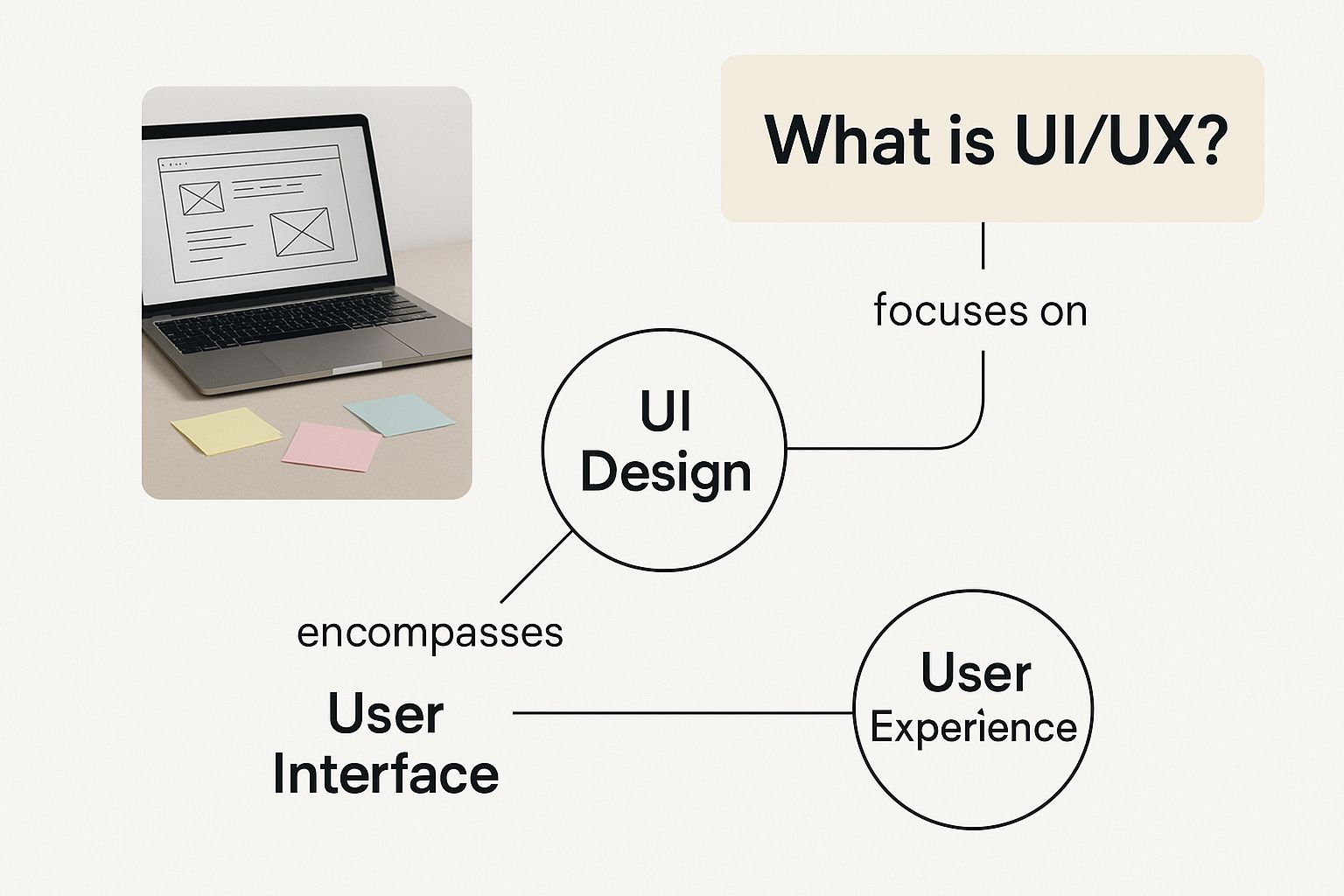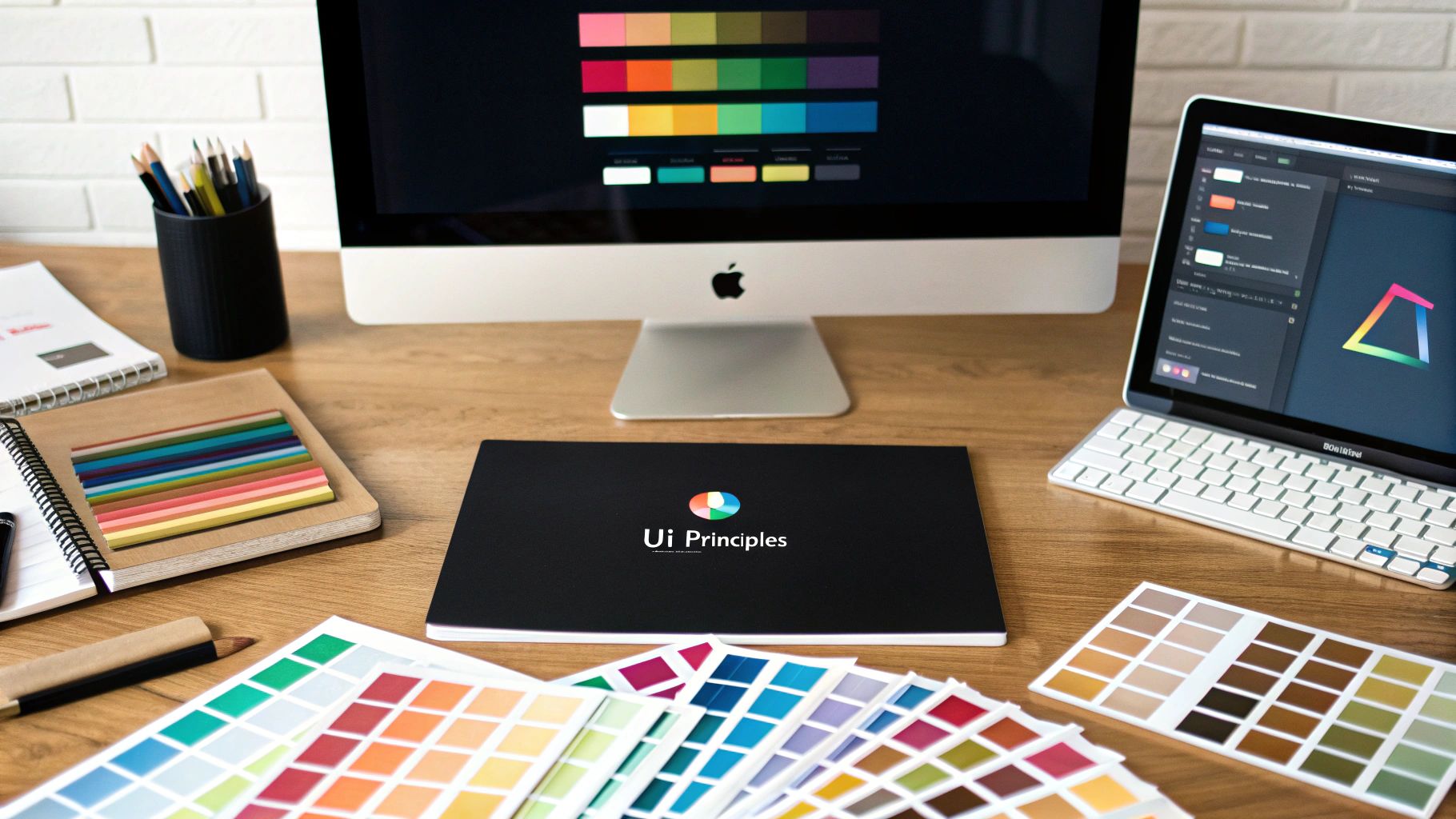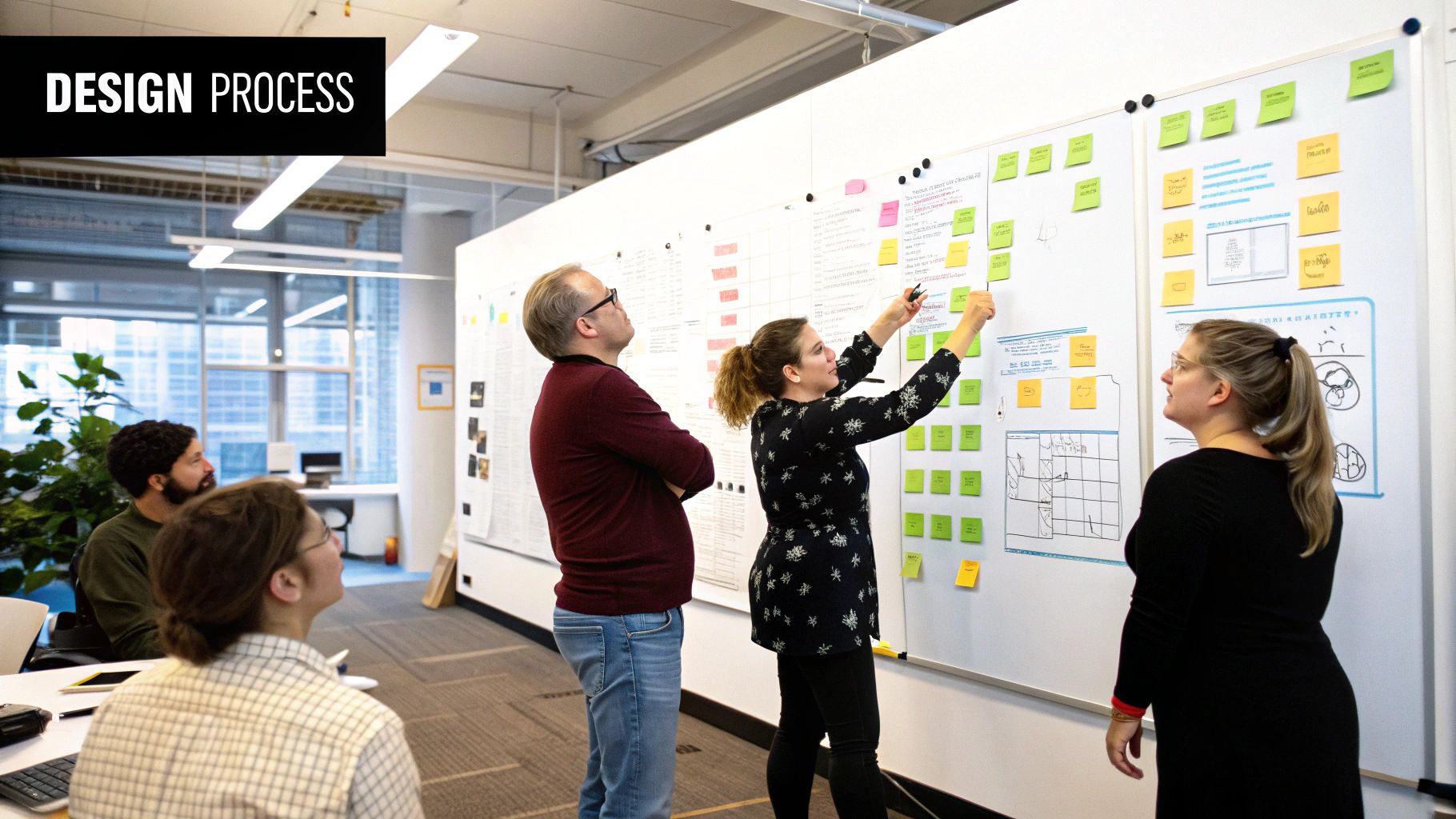At its core, UI/UX design is the strategic discipline of defining the relationship between a person and a product. It's helpful to break this down: User Experience (UX) is the comprehensive logic and emotional feel of the product's journey, while User Interface (UI) is the visual and interactive layer through which that journey is experienced.
The Blueprint and The Finishes
To fully grasp the distinct roles of UI and UX, we can use a practical analogy: constructing a house.
UX Design is the architect's blueprint. It is the rigorous, analytical work that ensures the structure is sound, the layout is logical, and the entire home meets the specific needs of the family who will live there. It's the foundational strategy. Is the kitchen positioned for efficient workflow next to the dining area? Are the bathrooms sufficient and well-placed? This is the domain of UX.
UI Design, conversely, is the work of the interior designer. This encompasses the tangible, sensory details—the colour palettes, the style of the light fixtures, the tactile feel of the door handles. It's the craft of making the house aesthetically pleasing and intuitive to inhabit. A house can't succeed without both; a visually stunning home with a confusing layout is a source of daily frustration, while a perfectly functional house that lacks any aesthetic appeal is hardly an inspiring place to live.
This infographic helps to visualise how these two distinct, yet deeply connected, disciplines come together.

As you can see, the foundational UX work, like wireframing and structuring the user journey, provides the skeleton that the polished UI is then built upon.
The Foundation of Digital Success
Mastering both disciplines is the key to creating digital products that are not just functional, but feel effortless and genuinely valuable to use. When UI and UX are perfectly harmonised, the result is a seamless experience that builds lasting user loyalty and drives sustainable business growth. For a deeper analysis of the professional field, you can explore more about the UX/UI Design industry.
Market trends underscore the critical importance of this synergy. The global UX services market is projected to expand from $2.59 billion in 2022 to an astounding $32.95 billion by 2030. Similarly, the UI design market is forecast to grow from $2.43 billion in 2024 to $7.43 billion by 2032, demonstrating that businesses worldwide are making substantial investments in user-centric design.
“A great product experience starts with UX followed by UI. Both are essential for the product’s success.” - Rahul Varshney, Co-creator of Foster.fm
This statement articulates a fundamental truth. A product that falters on either front misses a critical opportunity to connect meaningfully with its audience. In today's competitive landscape, understanding and executing on both UI and UX is not merely a beneficial practice; it is an indispensable component of modern product development. You can see how we apply these principles by exploring our dedicated UI/UX design services and our approach to building successful SaaS platforms.
Crafting The User's Journey Through UX Design
Having established the difference between the blueprint (UX) and the finishing touches (UI), let's delve deeper into the architectural process itself. User Experience (UX) design is the strategic heart of product development. It is best understood as a science of empathy, focused entirely on how a product feels and functions from the user's perspective. The focus is less on aesthetics and more on logic, flow, and effective problem-solving.
Exceptional UX is often invisible. When an application or website performs exactly as you expect, allowing you to complete tasks without conscious thought, you rarely pause to appreciate the meticulous planning that made it possible. That seamless feeling is the outcome of a deliberate, methodical process engineered to anticipate your needs before you even fully recognise them.
This journey, from a user’s underlying problem to a functional and elegant solution, is where UX designers demonstrate their true value. It involves shifting the organisation's focus from "what features can we build?" to "what success can we help the user achieve?".
The Core Stages of UX Design
The UX process is not based on guesswork. It is a structured framework for understanding the motivations and behaviours of the people who will actually use the product. Consider it a multi-stage investigation that begins broadly and progressively narrows to specific, tangible outputs. Each stage builds upon the last, ensuring the final product is grounded in empirical evidence, not internal assumptions.
This methodical approach typically involves several key stages:
- User Research: This is the foundational stage. Here, designers employ interviews, surveys, and observational techniques to gain a deep understanding of the target audience—their habits, goals, and pain points.
- Persona Creation: Using this rich research data, designers construct detailed fictional characters, or personas, that represent the primary user groups. These personas serve as a constant reminder to maintain a human-centred design process.
- User Journey Mapping: This entails creating a visual representation of the entire experience a user has with a product, from initial awareness to the final goal. This is an invaluable tool for identifying opportunities and potential friction points.
- Wireframing: In this stage, designers create low-fidelity skeletal layouts of the product's screens. These are not visually polished; their purpose is to define structure, layout, and functionality, leaving aesthetic design for a later phase.
At its core, UX is a problem-solving discipline. It's the meticulous work of mapping out every step a person takes to ensure their path is clear, logical, and free of frustration.
From Empathy to Economic Impact
This intense focus on the user's journey is not merely a "nice-to-have" exercise; it has a real, measurable economic impact. As User Experience (UX) design is so critical to a product's success, the UK market demonstrates a strong and growing demand for these skills. UX design roles are projected to be among the most sought-after in the UK, particularly within the technology, finance, and e-commerce sectors.
This demand is unsurprising when you consider the data. Starting salaries for entry-level UX designers in the UK are around £28,000, while senior professionals can command over £85,000 annually. This robust market is driven by a clear business insight: excellent UX leads directly to higher user engagement, improved customer retention, and ultimately, greater profitability. You can find out more about the demand for UX roles in the UK.
By investing in understanding the user's journey, businesses are not just creating better products; they are building a more sustainable and profitable future for themselves.
Creating The Visual Connection with UI Design

If UX design is the architect's blueprint, then User Interface (UI) design is the craft of the interior designer and electrician combined. It constitutes the tangible, sensory part of the experience that brings a product’s strategic foundation to life. UI encompasses every visual and interactive element a person sees, touches, and engages with.
This includes the buttons they click, the icons they recognise, and the colour schemes that establish the product’s overall tone. It is a common misconception that UI is simply about “making it look pretty.” In truth, it is about constructing a consistent and intuitive visual language that guides the user and builds brand trust with every interaction.
An exceptional UI should feel like a well-organised pilot's cockpit. While there is immense complexity under the surface, every control is clear, logically placed, and simple to operate. This clarity makes the experience feel not just functional, but also safe and dependable, transforming the functional UX blueprint into a compelling interactive reality.
Key Components of User Interface Design
Effective UI is constructed from several core visual elements working in concert to create a cohesive and predictable experience. A weakness in any of these areas can disrupt the user's flow and undermine their confidence in the product.
The primary elements are:
- Visual Design: This involves the strategic application of colour palettes, imagery, and typography to create a distinct look and feel that aligns perfectly with the brand’s identity.
- Layout and Spacing: The arrangement of elements on a screen is critical. A well-executed layout establishes a clear visual hierarchy, guides the user's eye, and prevents the interface from feeling cluttered or overwhelming.
- Interactive Elements: These are the functional components of the interface, such as buttons, sliders, input fields, and toggles. Their design must clearly communicate their function and current state (e.g., a button that changes appearance when pressed).
- Consistency and Patterns: Users expect certain elements to behave in familiar ways. Maintaining consistency across an application—such as using the same icon for the same action every time—reduces cognitive load and makes the product feel intuitive.
UI design is a purely digital practice. It’s all about creating an intuitive experience that doesn’t require the user to think too much! It visually guides the user through a product’s interface.
For those looking to deepen their understanding of visual principles, exploring the design process in graphic design can provide valuable insights that are directly applicable to UI. Ultimately, UI design is the bridge that makes technology feel both approachable and human.
The Symbiotic Relationship Between UI and UX
Considering User Interface (UI) and User Experience (UX) design as separate, competing disciplines is a common but fundamental error. In practice, they are two sides of the same coin, locked in a symbiotic relationship where one cannot realise its full potential without the other.
World-class digital products are not built on great UX or great UI; they are built on their masterful integration.
To see this synergy in action, consider a modern banking application. The UX designer is responsible for the core logic of the user’s journey. They meticulously map out the process for checking a balance, transferring money, or paying a bill to ensure it is intuitive, secure, and efficient. Their work answers the question: "Is this process logical and can the user achieve their goal without friction?"
The UI designer then takes this logical blueprint and brings it to life. They make the experience visually clear and effortless to navigate by selecting trustworthy colours, designing clean layouts, and crafting unambiguous buttons that inspire confidence. Their work answers the question: "Is this process visually intuitive and does it feel trustworthy?"
When both are perfectly aligned, users can manage their finances with speed and complete peace of mind.
When The Partnership Fails
The importance of this partnership becomes painfully obvious when one element is strong and the other is weak. These common failure points highlight why you absolutely need both to succeed.
Great UI, Poor UX: This is the classic "all style, no substance" scenario. Imagine a beautifully designed banking app with sleek animations and a stunning colour palette. But when you try to transfer money, the process takes seven confusing steps, and the "confirm" button is hidden in a completely illogical place. The app looks amazing but is ultimately unusable, leading to immense frustration and users deleting it for good.
Great UX, Poor UI: On the flip side, consider an app that is incredibly functional and logical. Every task is easy to complete, and the flow is perfect. However, the interface looks like it’s from the 90s, the fonts are jarring, and the colours feel unprofessional. While the app works well, its poor visual presentation completely undermines user trust. It feels insecure and amateurish, making users question the credibility of the bank itself.
An experience that looks brilliant but is hard to use is a classic example of excellent UI and poor UX. On the other hand, a product that is highly usable but looks dreadful demonstrates great UX and poor UI.
Ultimately, a product's success isn't determined by its individual parts but by how seamlessly they work together. A logical user journey (UX) must be presented through a clear and trustworthy interface (UI). One provides the strategic foundation, while the other delivers the tangible, interactive experience. Achieving this perfect harmony is what separates forgettable products from market leaders that users love and depend on.
The Tangible Business Value of UI/UX Design
It is crucial to move beyond conceptual understanding and recognise investment in UI and UX design as a powerful business driver, not merely a cost centre. While a refined interface and a smooth user journey are aesthetically pleasing, their true importance lies in the direct, measurable impact they have on bottom-line results.
For any professional in a leadership or product ownership role, understanding UI/UX is about translating design improvements into quantifiable commercial success.
Superior design is a direct line to profitability. A thoughtfully engineered user experience makes it simple for customers to find what they need and complete a transaction, which naturally boosts conversion rates. This is not anecdotal; research consistently shows that for every £1 invested in UX, the return can be as high as £100. This is not about making things look attractive; it is about constructing the most frictionless path to revenue possible.
Connecting Design to Business Metrics
An intuitive design process doesn't just increase sales; it strengthens the entire business. Clear navigation and logical user flows significantly reduce the number of users requiring customer support, thereby lowering operational costs. Simultaneously, a positive experience fosters repeat business and builds brand loyalty, directly increasing customer lifetime value (CLV).
Consider these connections:
- Reduced Cart Abandonment: A simplified and trustworthy checkout process—a hallmark of great UI/UX—can dramatically lower the nearly 70% of online shopping carts that are abandoned.
- Lower Support Costs: When users can easily find solutions independently, the demand for large support teams diminishes.
- Stronger Brand Equity: A professional, reliable, and pleasant user interface builds trust and positions your brand as a credible leader in its market.
Investing in UI/UX is not an expense. It's an investment in your customers, your brand, and your future profitability. By prioritising the user, you are fundamentally prioritising business growth.
To truly appreciate how design translates into concrete business outcomes, let's break down the return on investment.
Return on Investment of Professional UI/UX Design
This table illustrates how specific UI/UX activities lead directly to measurable business benefits.
As the table demonstrates, every facet of proficient design is geared towards a tangible, positive outcome for the business.
Ultimately, to effectively champion UI/UX investment within your organisation, you must speak the language of business outcomes. The initial outlay is a crucial part of the overall budget, and understanding how these costs fit into the bigger picture is key. For those planning a project, learning more about typical web app development costs can provide essential context for these discussions.
By presenting data-backed arguments that connect design to revenue and retention, you can prove that it's a direct path to a significant competitive advantage.
Modern Design Principles For Today's User
 Grasping the fundamentals of UI and UX design is the first step. The next is understanding the modern principles that distinguish a merely adequate product from a truly exceptional one. Today's users expect more than a tool that is functional and clean; they demand experiences built on respect, inclusivity, and responsibility.
Grasping the fundamentals of UI and UX design is the first step. The next is understanding the modern principles that distinguish a merely adequate product from a truly exceptional one. Today's users expect more than a tool that is functional and clean; they demand experiences built on respect, inclusivity, and responsibility.
This is where the conversation elevates beyond the basics to the non-negotiables that define a mature product strategy. These are not transient trends—they represent the bedrock of any digital product that aims for long-term success.
The Pillars of Responsible Design
To build genuine, lasting trust with your users, your design methodology must be built upon three key pillars. Each pillar addresses a different aspect of the user's relationship with your product, ensuring the experience is not only usable but also respectful.
These pillars are:
- Accessibility (A11y): This is the practice of ensuring your product can be used by people with the widest possible range of abilities. It means designing for individuals with visual, auditory, motor, or cognitive impairments, so your technology is genuinely inclusive.
- Inclusive Design: While related to accessibility, this is a broader concept. It is the conscious effort to consider the full spectrum of human diversity—including culture, gender, age, language, and background. The objective is to avoid unintentional exclusion and create products that feel welcoming to all.
- Ethical Design: This pillar is focused on respecting a user's autonomy and privacy. It represents a commitment to transparency and the avoidance of manipulative techniques, often called 'dark patterns', that coerce users into actions they did not intend.
True market leadership isn’t just about having the best features. It’s about demonstrating a mature and responsible approach that puts the user’s well-being and dignity at the centre of every design decision.
This shift toward more conscientious design is already reshaping the industry. In the UK, user experience has moved beyond pure aesthetics. As of 2025, there is a significant push to prioritise accessibility, with approximately 71% of users citing it as a critical factor in their digital interactions. This reflects a growing demand for ethical design that safeguards user privacy and builds long-term trust. You can explore more about these evolving UX design trends at UX Design Institute.
Common Questions About UI and UX Design
As we've examined the intricate relationship between UI and UX, several practical questions consistently arise. We regularly address these with clients and partners, so we have compiled the most common ones here to provide clear, direct answers.
Do I Need to Code to Be a UI UX Designer?
While you certainly do not need to be an expert developer, a foundational understanding of HTML and CSS provides a significant advantage for any designer. This knowledge helps ensure your designs are technically feasible from the outset.
More importantly, it enables you to "speak the same language" as the development team. This shared vocabulary facilitates smoother collaboration and elevates your role from a designer to a more effective strategic partner in the product development lifecycle.
For a New Product, Which Comes First: UI or UX?
UX must always come first. The success of any new product is predicated on its ability to solve a real user problem, which is the absolute core of User Experience.
Consider this: a solid UX foundation—established through rigorous research, user journey mapping, and wireframing—serves as the strategic blueprint for your product. UI design then follows to bring that blueprint to life visually. A beautiful product that fails to solve a user's problem is simply a beautifully designed failure.
How Do You Measure the Success of UI UX Design?
Success is measured by blending quantitative data with qualitative insights. The goal is to connect specific design improvements to tangible business outcomes.
- Quantitative Metrics: These are the hard numbers. This includes metrics such as conversion rates, task completion times, user retention figures, and error rates.
- Qualitative Insights: This is the human element of the evaluation. This feedback is gathered by conducting usability testing sessions, user interviews, and customer satisfaction surveys (like NPS).
Mastering these measurements is vital, especially when building different types of custom software where the criteria for success can vary significantly. By combining hard data with real human feedback, you achieve a comprehensive understanding of how a design is truly performing.
At Make IT Simple, we've spent over two decades turning great ideas into market-ready SaaS platforms that deliver results. If you're ready to build a product grounded in expert UI/UX principles, book a consultation with our team today. Find out more at https://www.makeitsimple.co.uk.


